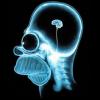Discussion
There is a tremendous unmet clinical need for effective pharmacological interventions against protein-misfolding neurodegenerative disorders such as Alzheimer’s and Parkinson’s diseases. The PERK branch of the UPR, in particular, has emerged as a promising new therapeutic target in these disorders, due to its overactivation in human Alzheimer’s disease brain tissue and mechanistic implications from disease models (Hetz et al., 2013; Halliday and Mallucci, 2014). Thus, in preclinical models, many lines of evidence support increased signalling via eIF2α-P—and the ensuing attenuation of protein synthesis rates—as contributing to cognitive impairment and disease progression (Moreno et al., 2012, 2013; Ma et al., 2013; Devi and Ohno, 2014; Kim et al., 2014; Halliday et al., 2015; Radford et al., 2015). Moreover, two compounds, the PERK inhibitor GSK2606414 (Moreno et al., 2013) and the ISR inhibitor ISRIB (Halliday et al., 2015) have been shown to interfere with the translational inhibitory effects of increased eIF2α phosphorylation (acting upstream and downstream of eIF2α-P, respectively). Both of these compounds have been shown to have significant neuroprotective effects in mouse models of neurodegeneration, reducing disease progression (Moreno et al., 2013; Halliday et al., 2015; Radford et al., 2015). GSK2606414 also improves neuronal phenotypes in fly models of disease (Kim et al., 2014; Celardo et al., 2016). Further, ISRIB boosts cognition in wild-type mice (Sidrauski et al., 2013). However, neither of these substances is suitable for translation to treatment of human disease, due to associated toxicity (GSK2606414) or insolubility (ISRIB) (Moreno et al., 2013; Halliday et al., 2015). There is therefore an urgent need to find safe compounds with similar therapeutic effects to test the potential efficacy of this approach in human disease. This need drove us to develop new screens to find potential repurposable drugs for translation to the clinic as new disease-modifying treatments for dementia.
The development of experimental models amenable to live animal compound screening is an attractive approach for discovering effective pharmacological therapies. Drug screens are often a balance between choosing the most biologically relevant readout, and maintaining a high-enough throughput to remain useful. We chose the nematode worm C. elegans for our primary in vivo screen due to the worms’ quick generational time, the ability to breed hundreds of developmentally synchronized animals for testing and easily observable phenotypes. Importantly, the UPR is conserved across metazoa, and C. elegans contains orthologues of all the major UPR genes. Tunicamycin induces developmental arrest in the worms at stages L2/L3. This likely occurs as they normally greatly increase in size between the L2 and L3 stages, requiring large amounts of new protein synthesis, which is attenuated by tunicamycin (Supplementary Fig. 1). Due to the large difference in size between worms that were stalled at the L2 stage and older worms that had overcome the developmental block, compounds that exerted any beneficial effects were easily observed (Supplementary Table 1). We used a NINDS Custom Collection 2 drug library including mostly FDA-approved drugs, many of which were known to be brain-penetrant and neurologically active in humans. Twenty of the 1040 NINDS compounds overcame the developmental delay in tunicamycin-stressed worms and were therefore potential UPR inhibitors (Supplementary Table 1). However, this screen did not determine whether the drugs were direct inhibitors of the UPR. The upregulation of chaperones, or the drugs themselves acting as chemical chaperones, could similarly facilitate normal development in the worms. We therefore screened the 20 hits in mammalian CHO CHOP::luciferase cells to test for inhibition of PERK-mediated UPR signalling (Fig. 1A and B). Five of the 20 compounds repressed CHOP::luciferase signalling induced by tunicamycin. Of these, trazodone, a licensed anti-depressant safe to use in the elderly, with excellent oral pharmacokinetic profile and excellent safety profile and DBM, a curcumin analogue with notable anti-cancer properties in preclinical models, were the best candidates to take forward.
Trazodone is an antidepressant in the serotonin antagonist and reuptake inhibitor class, which has additional anxiolytic and hypnotic effects. It has been shown to reduce the behavioural and psychological symptoms of dementia (BPSD) in Alzheimer’s disease (Lopez-Pousa et al., 2008) and in FTD (Lebert et al., 2004), but no studies have looked at the progression of neurodegeneration with trazodone treatment. Although its pharmacological actions in humans are not fully understood, it is thought to have more than one mechanism of therapeutic action, making it a multifunctional drug. It is the first antidepressant with a dual mechanism of action involving inhibition of the serotonin transporter (SERT) and antagonism of the serotonin type 2 (5-HT2) receptor, producing its antidepressant effect by blocking SERT, and increasing serotonin concentrations in the brain. Trazodone exerts antagonistic properties against α1- and α2-adrenergic receptors and histamine H1 receptors, with minimal anticholinergic effects (Monti et al., 1986; Stahl, 2009). Trazodone has previously shown benefit in models of Huntington’s disease, where it improved mitochondrial respiratory complex activity (Kumar et al., 2011) and Morris water maze performance (Kumar et al., 2010)
DBM is a minor constituent of liquorice that has been found to have antineoplastic effects, with efficacy against prostate and mammary tumours (Huang et al., 1998; Khor et al., 2009). Carcinogen detoxification has been proposed as a possible mechanism of action as DBM has been reported to potently induce phase 2 hepatic detoxification enzymes (Dinkova-Kostova and Talalay, 1999). DBM has also been reported to induce the Nrf2 survival pathway (Thimmulappa et al., 2008), which is activated downstream of UPR activation (He et al., 2001). DBM has also been shown to upregulate GRP78/BiP (Frazier et al., 2004). DBM derivatives have been shown to induce protection from necrotic cell death (Hegedus et al., 2013) and protect dopaminergic neurons against both oxidative stress and endoplasmic reticulum stress (Takano et al., 2007). It is unclear if DBM itself shares these effects with its derivatives.
In this study, we found that both trazodone and DBM inhibited the effects of UPR activation and eIF2α phosphorylation, reversing translational attenuation and lowering levels of ATF4 and CHOP in mammalian cells (Figs 1A and 2B). This occurred without lowering eIF2α-P levels in vitro (Fig. 2B), and in vivo (Figs 3H and 4G), as has been described for ISRIB (Halliday et al., 2015; Sekine et al., 2015; Sidrauski et al., 2015). Both trazodone and DBM prevented eIF2α-P from lowering ternary complex levels, due to their ability to reduce ATF4 5’UTR regulation of luciferase (Fig. 2D), but this was via an independent mechanism than that of ISRIB (Supplementary Fig. 2).
Based on their ability to reverse UPR activation, trazodone and DBM were predicted to be potential therapeutic candidates for neurodegenerative disorders. Indeed, both compounds were found to be substantially neuroprotective in two different mouse models of neurodegeneration, prion disease and the rTg4510 tauopathy model of FTD. Both drugs showed beneficial neuroprotective effects similar to those of the experimental compounds GSK2606414 and ISRIB. Importantly, in both models, the drugs were first administered at a stage of early but established disease, equivalent to early symptomatic human disease—from 7 weeks post-infection in prion-disease mice and from 4 months of age in tauopathy mice. Treatment with each drug prevented neuronal loss in the hippocampus (Fig. 3B and C) and confirmatory neurological clinical signs (Table 1) in the majority of prion-infected mice, also restoring memory and preventing behavioural decline associated with prion infection (Fig. 3D and E). In tauopathy mice, both drugs were strongly protective against the marked hippocampal neuronal loss and forebrain atrophy that is a feature of this mouse model (Fig. 4B and C). These mice were also devoid of clinical signs of neurodegeneration. There was also significant increase in lifespan of prion-infected mice treated with trazodone or DBM (Fig. 3F), although this was more modest than was expected considering the neuroprotection observed, due to coincidental weight loss requiring early sacrifice of otherwise entirely healthy animals (Fig. 3G). This weight loss was not caused by trazodone or DBM (Figs 3G and 4F), which, critically, were also devoid of pancreatic toxicity [Figs 3B(ix–xii), 4B(xiii–xvi) and Supplementary Fig. 2), likely because both compounds only partially reverse eIF2α-P-mediated translational attenuation (Fig. 1A and B), which is associated with lack of toxicity to secretory tissue (Halliday et al., 2015). Thus, neither trazodone nor DBM suffer from the shortcomings of GSK2606414 and ISRIB: they are non-toxic to the pancreas and have favourable pharmacokinetic properties. Critically, however, they share the benefits of GSK2606414 and ISRIB, being markedly neuroprotective.
Interestingly, another unanticipated and previously unreported action of trazodone was to lower phosphorylated (p)-tau levels in rTg4510 mice (Fig. 4B, E and Supplementary Fig. 4). P-tau is associated with Alzheimer’s disease pathology and with the tauopathies FTD and progressive supranuclear palsy, and is in itself an intense focus for Alzheimer’s therapeutics. This additional effect of trazodone could be considered a desirable bonus in the treatment of these disorders. UPR activation is known to induce tau phosphorylation via activation of GSK3β (Nijholt et al., 2013) and treatment with the PERK inhibitor GSK2606414 also lowers tau phosphorylation (van der Harg et al., 2014; Radford et al., 2015). Trazodone was also able to inhibit GSK3β (Supplementary Fig. 4). However, the similar degree of neuroprotection afforded by trazodone and DBM (Table 1, Figs 3B, C, 4B and C) suggests that reduction of the stress response downstream of eIF2α-P and partial restoration of protein synthesis is the primary driver of neuroprotection in both tauopathy and prion-diseased mice. This is irrespective of sustained high levels of misfolded protein, both prion (Fig. 3J) and p-tau (in DBM treated mice; Fig. 4B and E), further demonstrating the central role the UPR plays in neurodegeneration.
In conclusion, we selected trazodone and DBM as potential therapeutic agents in neurodegenerative disease, based on their consistent ability to inhibit UPR/ISR-induced translational repression, rather than target disease-specific misfolded proteins, in organisms ranging from nematodes, through mammalian cell models, to different mouse models of neurodegeneration. The two drugs were markedly neuroprotective in both prion-diseased and FTD mice at clinically relevant doses over a sustained treatment period. These drugs therefore represent an important step forward in the pursuit of disease-modifying treatments for Alzheimer’s and related disorders. Trazodone in particular, is already licensed for use in elderly patients. These drugs should now be tested in clinical trials in the treatment of dementia.















































